- Books Name
- A TEXT OF BIOLOGY - CLASS XII
- Publication
- ACME SMART PUBLICATION
- Course
- CBSE Class 12
- Subject
- Biology
BIODIVERSITY CONSERVATION
(A) Why should we conserve biodiversity? There are many reasons (all equally important) to conserve biodiversity.
These reasons can be grouped into three categories :
(a) The narrowly utilitarian aspect : Economic importance
(i) Pinus, Abies and Boswellia are major source of paper.
(ii) Pine resin is obtained from Pinus while damar from Shorea robusta.
(iii) Gums: Kuteera gum (Stericulia urens), Bengal Kino gum (Butea monosperma), salar (Boswellia serrata), safed dhaora (Anogeissus latifolia) , gum arabic (Acacia senegal) etc.
(iv) Tannin sources: Uncaria (leaves and young branches), Acacia (bark), Juglans (bark), Caesalpinia (wood and fruits).
(v) Important dyes are: Cutch / Kattha (heartwood of Acacia catechu), henna (leaves of Lawsonia inermis), haematoxylon (heartwood of Haematoxylon campechianum).
(vi) Plants can also be used to manufacture innumerable synthetic products, called botanochemicals.
Some Important Drugs
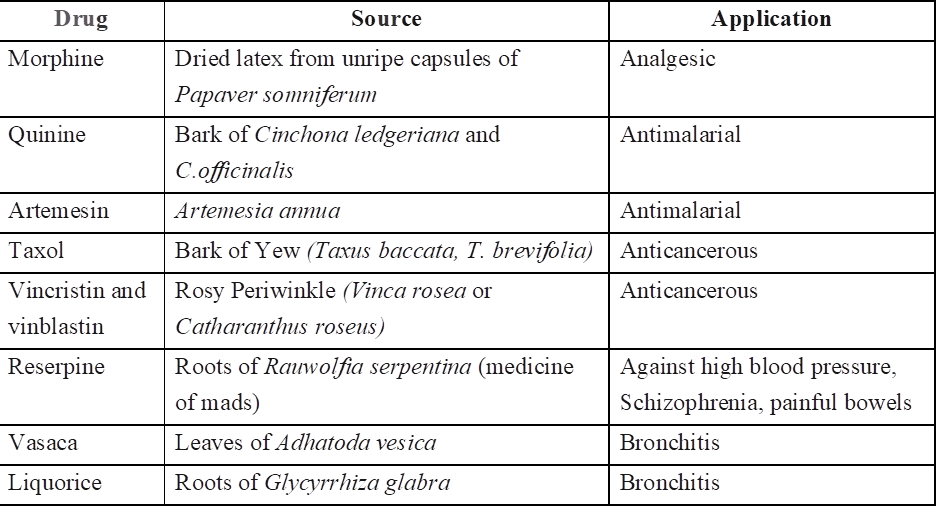
More than 25% of the drugs currently sold in the market worldwide are derived from plants and 25,000 species of plants, contribute to the traditional medicines used by the natives.
(vii) Bioprospecting: Exploring molecular, genetic and species level diversity for products of economic importance.
(b) Broadly utilitarian aspect: Ecosystem services are important, that nature provides.
(i) Amazon forest is estimated to produce 20% of the total 02 in the earth's atmosphere through photosynthesis.
(ii) Pollination -essential for seeds, fruits.
(iii) Flood and erosion control
(iv) Aesthetic pleasures
(c) Ethical aspect: Every species has an intrinsic value, so we have a moral duty to care for their well being.
(B) How do we conserve biodiversity?
1. Concept of Threatened Species The International Union of Conservation of Nature and Natural Resources (IUCN) has classified the rare species of plants and animals into different categories for the purpose of conservation. The classification is based on :
(i) The distribution of species in past and present.
(ii) The decline in number of populations in course of time.
(iii) The abundance and quality of natural habitat.
(iv) The biology and potential value of the species.
The IUCN Red List Categories
The IUCN Red List is a catalogue of taxa that are facing the risk of extinction.
It is important to understand that the Red List aims to impart information about the urgency and scale of conservation problems to the public and policy makers.
The uses of the Red List are :
(i) Developing awareness about the importance of threatened biodiversity.
(ii) Identification and documentation of endangered species.
(iii) Providing a global index of the decline of biodiversity.
(iv) Defining conservation priorities at the local level and guiding conservation action.
The World Conservation Union (formerly known as IUCN) has recognised eight Red List Categories of species: Extinct, Extinct in the Wild, Critically Endangered, Endangered, Vulnerable, Lower Risk, Data Deficient, and Not Evaluated.
List of endangered plants in India include orchids (especially Blue Vanda) , most of tree ferns, pitcher plant (Nepenthes khasiana), Podophyllum, etc.
The IUCN Red list Categories
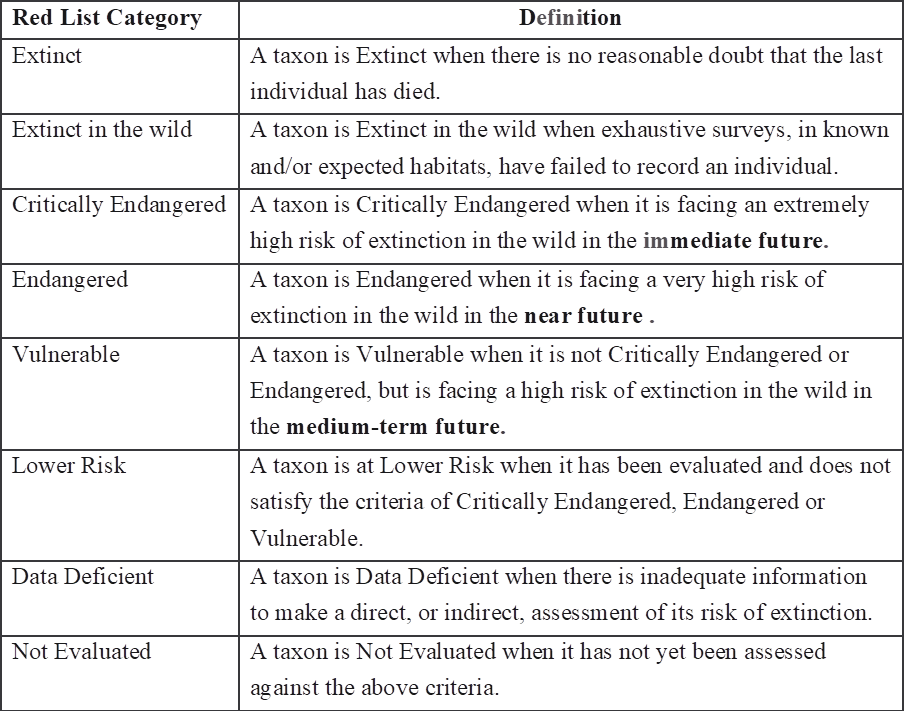
Examples of threatened species in India

2. Conservation Strategies
Some of the steps proposed to protect the existing species of the wild life are discussed below:
(i) The threatened species should be given preference over others in conservation.
(ii) The national protection programmes in different countries should be coordinated with the international programmes, particularly the biosphere reserve programme of the UNESCO's Man and the Biosphere Programme (MAB). The international network of biosphere reserve programme aims to conserve and use the diversity of living organisms for the present and the future within natural ecosystems.
(iii) Every country should set up national parks and sanctuaries to protect wild life and to ensure its multiplication.
(iv) Hunting should be regulated. It should be banned during breeding season of the animals. Killing of young animals should be prohibited.
3. There are two basic strategies of biodiversity conservation, in-situ (on-site) and ex-situ (off-site).
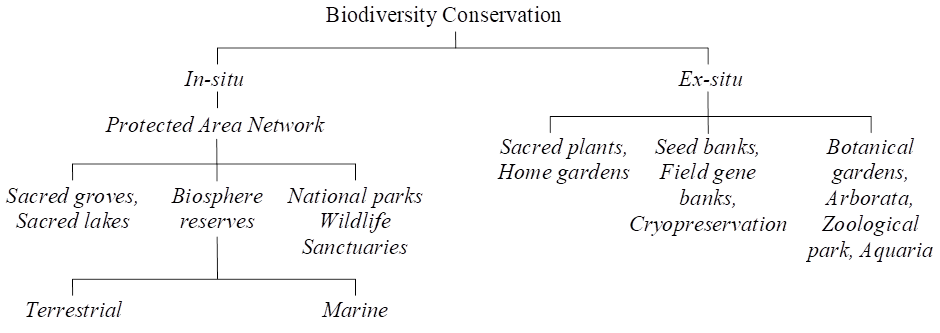
(A) In-situ (on site) Conservation Strategies
The in-situ strategies emphasise protection of total ecosystems. The in situ approach includes protection of a group of typical ecosystems through a network of protected areas.
Protected Areas: These are areas on land and/or sea, especially dedicated to the protection and maintenance of biological diversity, and of natural and associated cultural resources. These are managed through legal or other effective means. Examples of protected areas are National Parks and Wildlife Sanctuaries. The earliest national parks, the Yellowstone in USA and the Royal near Sydney, Australia, were chosen because of their scenic beauty and recreational values. India has (90 National Parks and 448 Wildlife Sanctuaries), covering 4.7% of the land surface, as against 10% internationally suggested norm. The Jim Corbett National Park was the first National Park established in India.
Some of the main benefits of protected areas are :
(i) Maintaining viable populations of all native species and subspecies;
(ii) Maintaining the number and distribution of communities and habitats, and conserving the genetic diversity of all the present species;
(iii) Preventing man-made introductions of alien species; and
(iv) Making it possible for species to shift in response to environmental changes.
Biosphere Reserves: Biosphere reserves are a special category of protected areas of land and/or coastal environments, wherein tribal people are an integral component of the system. These are representative examples of natural biomes and contain unique biological communities. The concept of Biosphere Reserves was launched in 1975 as a part of UNESCO's Man and Biosphere Programme, dealing with the conservation of ecosystems and the genetic resources contained therein. There are 14 biosphere reserves in India. A Biosphere Reserve consists of core, buffer and transition zones. The natural or core zone comprises an undisturbed and legally protected ecosystem. The buffer zone surrounds the core area, and is managed to accommodate a greater research and educational activities. The transition zone, the outermost part of the Biosphere Reserve, is an area of active cooperation between reserve management and the local people, wherein activities like settlements, cropping, forestry, recreation and other economic uses continues in harmony with conservation goals.
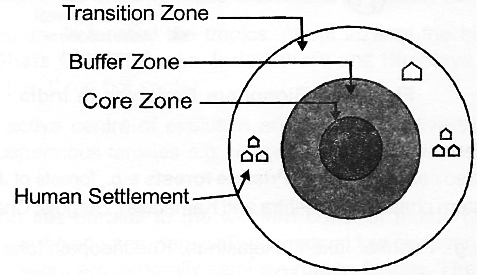
The main functions of biosphere reserves are :
(i) Conservation
(ii) Development
(iii) Scientific research, monitoring and education
A traditional strategy for the protection of biodiversity has been in practice in India and some other Asian countries in the form of sacred forests. In India, sacred forests are located in several parts e.g., Karnataka, Maharashtra, Kerala, Meghalaya etc. and are serving as refuge for a number of rare, endangered and endemic taxa. Similarly, several water bodies (e.g., Khecheopalri lake in Sikkim) have been declared sacred by the people, leading to protection of aquatic flora and fauna.
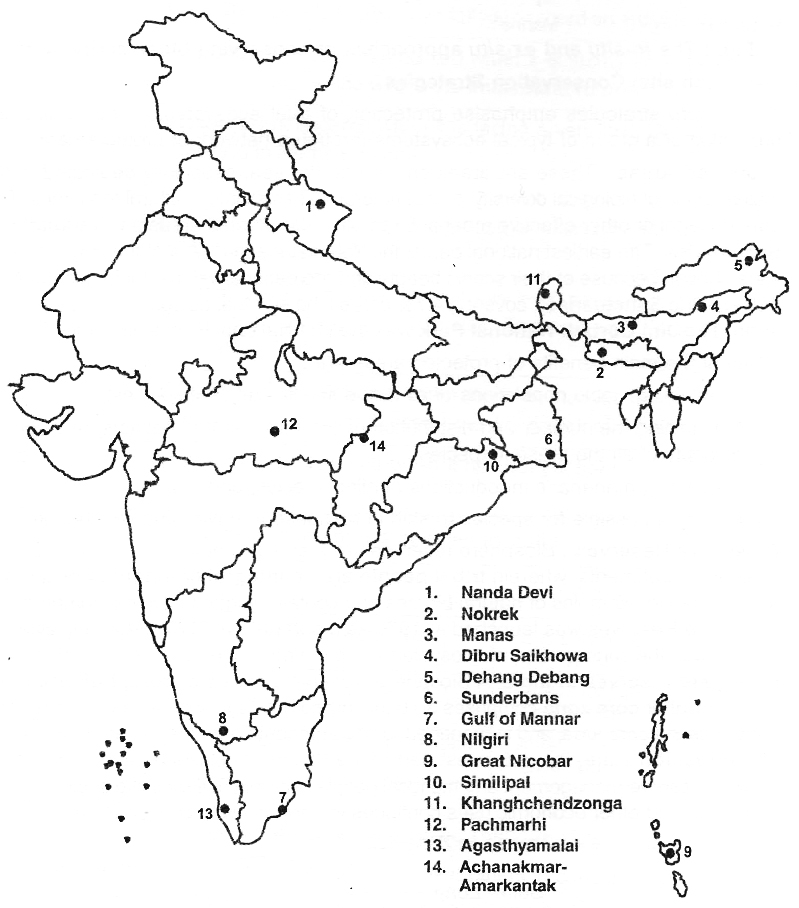
Sacred grooves
(i) Sacred forests: also called Islands of Pristine forests e.g., forests of Jaintia &Khasi (Meghalaya), Aravalli (Rajasthan), Westem ghats (Maharashtra and Karnataka), Surguja, Chanda and Bastar area (M.P.).
(ii) Sacred lakes: e.g., Pushkar lake in Rajasthan, Khecheopalri lake in Sikkim.
(iii) Sacred plants are Ocimum sanctum (Tulsi), Elaeocarpus floribundus, Ficus religiosa etc.
(B) Ex-situ (off site) Conservation Strategies
The ex-situ conservation strategies include botanical gardens, zoos, gene, pollen, seed, seedling, tissue culture and DNA banks.
Seed gene banks are the easiest way to store germplasm of wild and cultivated plants at low temperature in cold rooms.
Preservation of genetic resources is carried out in field gene banks under normal growing conditions.
In vitro conservation, especially by cryopreservation in liquid nitrogen at a temperature of -196°C, is particularly useful for conserving vegetatively propagated crops like potato.
Cryopreservation is the storage of material at ultra-low temperature either by very rapid cooling (used for storing seeds), or by gradual cooling and simultaneous dehydration at low temperature (used for tissue culture).
The material can be stored for a long period of time in compact, low maintenance refrigeration units.
Botanical gardens and arboreta may also have seed banks, tissue culture facilities and other ex-situ technologies. Many of the zoos are conducting captive breeding programmes.
HOT SPOTS OF BIODIVERSITY
Norman Myers developed the concept of hot spots in 1988 to designate priority areas for in-situ conservation.
The hot spots are the richest and the most threatened reservoirs of plant and animal life on earth.
The key criteria for determining a hot spot are:
(i) Number of endemic species i.e. the species which are found in a restricted area only.
(ii) Degree of threat, which is measured in terms of habitat loss.
Initially 25 terrestrial hot spots have been identified globally.
But now the number is raised to 34 with an area of less than 2%.
The number of species they collectively harbour is extremely high and strict protection of these hot spots could reduce the ongoing mass extinctions by almost 30%.
As many as 16 hot spots are in located the tropics.
About 20% of the human population lives in the hotspot regions.
Western Ghats and Sri Lanka, Indo-Burma and Himalaya cover our country's exceptionally high biodiversity regions (i.e. three hot spots).
Eastern Himalaya is an active centre of evolution and has a rich diversity of flowering plants, their occur numerous primitive angiospermous families e.g., Magnoliaceae, Winteraceae and primitive genera of plants, like Magnolia and Betula.
The Western Ghat region lies parallel to the western coast of Indian peninsula for almost 1600 km, in Maharashtra, Karnataka, Tamil Nadu and Kerala.
The forests at low elevation are mostly evergreen, while those found at 500-1500 meter height are generally semi-evergreen forests.
The Agasthyamalai hills, the Silent Valley and the new Amambalam Reserve, are the main centres of diversity.
The historic convention on Biological Diversity (The Earth Summit) held in Rio de Janeiro in 1992, called upon all nations to take appropriate measures for conservation of biodiversity and sustainable utilisation of its benefits.
In a follow-up, The World Summit on sustainable development held in 2002 in Johannesburg, South Africa, where 190 countries pledged their commitment to achieve, a significant reduction in the current rate of biodiversity loss of global, regional and local levels by 2010.
Some Important Definitions
1. Genetic diversity : A single species might show high diversity at the genetic level over its distributional range.
2. Species diversity: The diversity at the species level.
3. Community or ecosystem diversity: It is diversity at community and ecosystem levels.
4. Alpha diversity () : Refers to the diversity of organisms sharing the same community or habitat.
5. Beta diversity () : The rate of replacement of species along a gradient of habitats or communities.
6. Gamma diversity () : Diversity of the habitats over the total landscape or geographical area.
7. Endemism: Species confined to that region and not found anywhere else.
8. In situ conservation (on site) : It is conservation and protection of the whole ecosystem and its biodiversity at all levels in order to protect the threatened species.
9. Ex situ conservation (off site) : It is conservation of selected rare plants/animals in places outside their natural homes.
10. Paradox of enrichment: Conditions favouring growth do not induce biodiversity or speciation.
11. Critically Endangered : When a taxon is facing an extremely high risk of extinction in the wild in the immediate future.
12. Endangered: When a taxon is facing a very high risk of extinction in the wild in the near future.
13. Vulnerable: When a taxon is not critically endangered or endangered but is facing a high risk of extinction in the wild in the medium term future.
14. Biosphere reserves: A special category of protected areas of land and/or coastal environments, wherein tribal people are an integral component of the system.
15. Hot spots: These are areas of high endemism and very high levels of species richness.
16. National parks: These are areas reserved for wildlife where the latter is able to obtain all the required natural resources and habitats.
17. Sanctuaries: These are tracts of land with or without a lake where animals are protected from all types of exploitation and habitat disturbance.
18. Cryopreservation: In vitro conservation in which tissue, organs, embryos, seed etc. are stored at very low temperature of -196°C (temperature of liquid nitrogen).

 ACME SMART PUBLICATION
ACME SMART PUBLICATION
